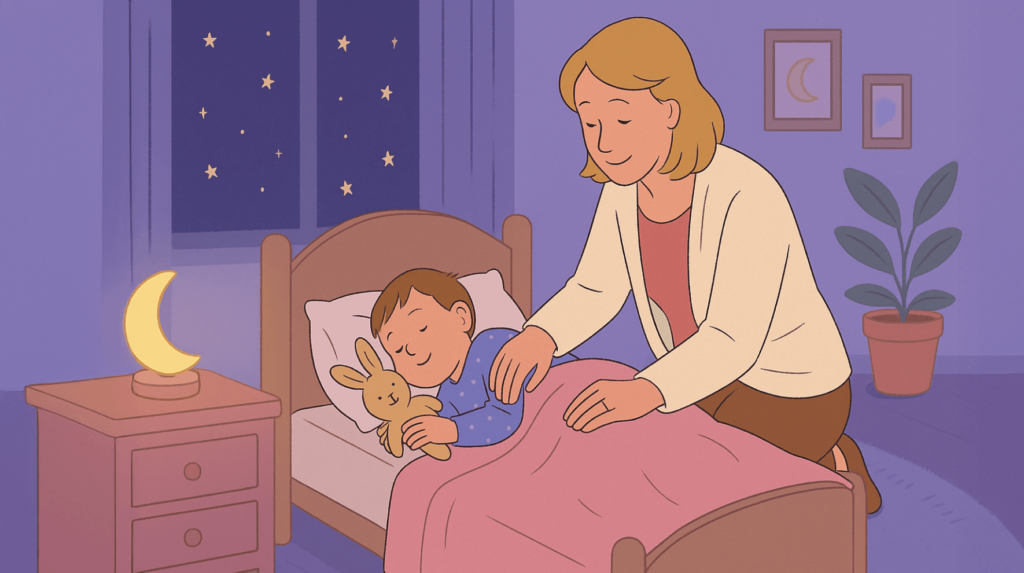Toddlers live life in fast-forward – one moment they’re scaling the couch, the next they’re melting down over the wrong color cup. And after all that action, you’d think bedtime would be easy, right? Not always.
Some nights, they’re out like a light. Other nights, they resist with every ounce of energy (sometimes both… in the same week!).
This guide is here to help you set realistic expectations and find calm in the bedtime chaos. With insights from pediatric gentle sleep coach and founder of Sleep Like a Baby Consulting, Debbie Gerken, we’ll walk through what’s normal, why toddlers fight sleep, and the small rituals that can make nights a little smoother.
How much sleep does a toddler need?
According to the American Academy of Sleep Medicine, most toddlers thrive on about
- 11 – 14 hours of total sleep at ages 1 – 2
- 10 – 13 hours of total sleep by ages 3 – 5 including naps
Regarding naps, many 12 – 18-month-olds shift from two naps to one longer afternoon nap. As kids approach preschool years, that single nap shortens or fades. By around age 5, most kids have dropped daytime sleep altogether.
“ Many toddlers go through a stage of napping some days and skipping on others and that’s very normal. During this period, parents can help by moving bedtime earlier on no-nap days, building in some quiet downtime (like looking at books or resting in their room), and being flexible as their child’s sleep needs change.”
Why doesn’t my toddler sleep?
You’ll hear it all the time: “My kid is so naughty, he never seems tired!” The truth? That’s not naughtiness – it’s biology plus big feelings. Toddlers are wired to test boundaries, their sleep pressure fluctuates with activity and timing, and separation can feel huge at bedtime.
“Just one more story….!”
Toddlers are expert negotiators. After a day of following rules, bedtime is their chance to push back. They’ll bargain hard, but steady routines and consistency help calm the battles.
“ Toddlers are natural boundary testers and they have a desire to assert control. Bedtime is a prime opportunity to do that, especially after a day of being asked to follow instructions, boundaries, and perhaps have had limited ability to have a say in their day.”
“He’s never tired.”
Toddlers rarely admit they’re sleepy. Late naps, active play, or screen time can trick their bodies into thinking it’s still time for fun, not rest.
“But mommy, the dark is scary.”
As imagination grows, so do fears. Shadows, noises, and monsters feel bigger at night. Separation plus darkness can feel overwhelming without comfort.
“Why is she up at 5 a.m. ready to play?”
Early waking is common. A maturing body clock, morning light, hunger, or quick interactions convince them the day has started.
Night terrors vs nightmares – “What just happened?”
Nightmares happen in lighter sleep, that is when your child wakes frightened and remembers.
Night terrors happen in deep sleep, thrashing or shouting, but no memory the next day. However, both are normal signs of brain development.
“Do I need to move him from the crib to the bed?”
Climbing out feels like victory. But toddlers lack the self-control for that freedom, often leading to wandering and fresh bedtime challenges.
It’s okay. It’s not so bad. And there are straightforward ways to make nights easier.
How to get my toddler to sleep?
Parents everywhere whisper the same wish at night: please, just sleep. Toddlers, however, often have other plans.
‘But Daddy, I’m still playing!’
‘Can I have another hug?’
Yes, bedtime can feel like a marathon. With the right approach, it gets calmer, cozier, and easier for everyone.
Build a bedtime routine (bath → book → cuddle)
Toddlers feel safe when they know what comes next. A simple routine – bath, book, cuddle – helps their little bodies and minds relax. The more consistent you are, the easier bedtime feels for everyone.
“ Stay as consistent as possible with the bedtime routine and sleep expectations, while offering plenty of comfort and reassurance.”
Keep a predictable schedule
Kids thrive on rhythm. Try for steady wake-ups, naps, and bedtimes. If things have drifted late, no worries, just ease bedtime earlier in small steps. Gentle changes really do add up.
Shape the environment
Make the room cozy and calm: dark, quiet, with a soft nightlight if needed. White noise can help, but keep it at a safe distance. You can also turn off screens an hour before bed and swap them for snuggly stories or quiet play.
A favorite lovey or soft toy gives extra comfort when they stir at night. For early birds, keep the room dark and mornings low-key until it’s truly time to get up.
And remember: safety first always matters most.
Gentle limits that stick
Your toddler will test you and that’s part of growing. Set clear limits (two books means two) and keep check-ins short and calm. You’re showing them: “I’m here, you’re safe, and it’s still bedtime.”
Transitioning from crib to bed
When climbing out begins, the big-kid bed is around the corner. Keep everything else the same – same routine, same rules, same comfort. If they wander, quietly walk them back. With patience, they’ll learn new freedom and can still feel safe and cozy.
When setting up your toddler’s sleep space, it’s worth revisiting the basics of safe sleep practices to make sure comfort never comes at the expense of safety.
Should I teach my toddler to self-soothe?
The biggest gift we give our kids is confidence to settle and resettle. That doesn’t mean “cry-it-out” or ignoring needs; it means responding calmly and consistently so they learn what to expect.
“ A parent can always make gentle changes to support more independent sleep. Children are adaptable, and with consistency and patience, they can learn new skills at any stage.”
Use the routine to cue sleepy brains, keep wake-ups low-key, and allow a few minutes for them to try before you step in. Over time, most toddlers get better at linking sleep cycles on their own.
Conclusion
So hang in there, fellow tired parent. The nights may be long, but the years are short. And in between the yawns, there’s magic – the kind you’ll remember long after your toddler finally does sleep through the night.
With routines, a little patience, and a lot of love, bedtime slowly shifts from a nightly battle into a nightly ritual. And while your toddler may not always thank you now, one day you’ll look back and smile at how much comfort those simple, steady steps gave them.
FAQs
Q: 1. What’s a realistic bedtime for toddlers?
A: Most toddlers do best with bedtime between 7:00 – 8:00 p.m. A consistent sleep window helps their body clock stay on track.
Q: 2. How do I handle early-morning waking?
A: Keep the room dark, avoid exciting interactions before 6 a.m., and offer an early, balanced breakfast to prevent hunger from waking them.
Q: 3. Can white noise help toddlers sleep?
A: Yes – when used safely. Place the machine away from the crib/bed, keep volume moderate, and choose steady sounds over loud or erratic ones.
Q: 4. How long does it take for a new sleep routine to work?
A: Consistency is key. Most toddlers adjust within 1 – 2 weeks of sticking to the same routine and schedule.
Q: 5. Is it normal for toddlers to wake up at night?
A: Yes. Many toddlers briefly wake as they shift sleep cycles. The goal is to help them learn to resettle with minimal help.
Sources:
- How many hours does a toddler need?. AAP. “Healthy Sleep Habits: How Many Hours Does Your Child Need?”
- Usage of dim light. NHS.UK. “Sleep and young children”
- Bedtime routine for toddlers’ sleep. NCBI. 2009. “A Nightly Bedtime Routine: Impact on Sleep in Young Children and Maternal Mood”
- Check on sound pressure levels. Pediatrics. 2014. “Infant Sleep Machines and Hazardous Sound Pressure Levels”
- When to switch from crib to bed?. AAP. “Big Kid Beds: When to Switch From a Crib”
- Sticking to a bedtime routine. AAP. “Toddler Bedtime Trouble: 7 Tips for Parents”




